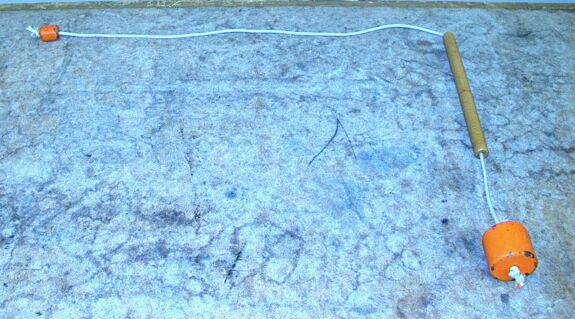
Hold the hollow wood rod upright in one hand, above the level of your head, with the large mass hanging down from the bottom, and the small mass at the top. Now move the rod in such a way as to twirl the small mass around in a horizontal circle. As you do this, the tension necessary to keep the small mass moving in a circle exceeds the weight of the large mass. The large mass is thus pulled upwards. If you twirl hard enough, you can lift the large mass all the way to the bottom of the wood rod.
This apparatus consists of a rope that goes through a hollow wooden rod, and which has at one end a large iron mass, and at the other end a small iron mass. To use it, you hold the rod as described above – above head level, with the large mass hanging from the bottom. As you twirl the small mass, the rope provides the centripetal acceleration necessary to keep it moving in a circle. Expressed in terms of the instantaneous tangential speed of the mass, v, and the radius of the circle in which it is moving, r, this acceleration is v2/r. (See demonstration 16.03 -- Ball on turntable.) The centripetal force, then, which is the tension in the rope, is mv2/r, where m is the mass of the small iron mass. If this tension exceeds the weight of the large mass (and the friction between the rope and the wooden handle), then the circling small mass pulls the large mass upward.
You can also note that once you have raised the large mass by twirling the smaller one in a circle, when you stop twirling, as the large mass falls back down and the radius of the circle traveled by the small mass becomes shorter, the instantaneous tangential velocity of the small mass increases. This is a nice illustration of the conservation of angular momentum. The angular momentum of a circling object equals mvr, where m is the mass of the object, v is its instantaneous tangential speed, and r is the radius of the circle in which it is moving. Since there is no torque acting on the mass as the rope pulls on it, its angular momentum must remain constant. So mvfrf must equal mviri, where the subscripts f and i stand for “final” and “initial,” respectively. So as the radius of the circle decreases, the instantaneous tangential speed of the object must increase (vf = vi(ri/rf)). Since v = ωr, where ω is the angular speed of the object, in terms of angular speed, the angular momentum is mωr2, and ωf = ωi(ri2/rf2).
References:
1) Resnick, Robert and Halliday, David. Physics, Part One, Third Edition (New York: John Wiley and Sons, 1977), p. 270.